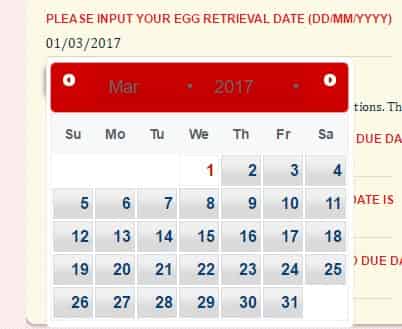

Frozen blastocyst transfers should have hatching and the beginning of implantation by about 1-3 days after the FET.Įarly pregnancy detection following blastocyst transfer is possible with a sensitive blood assay for HCG hormone by about 9 days after a fresh or frozen blastocyst transfer.Ī urine HPT (home pregnancy test) can be done by 10 to 12 days after blastocyst transfer (fresh or frozen), if it is a sensitive, high quality test kit.Once you become pregnant after an IVF cycle, it’s relatively simple to calculate your due date. However, the embryo implantation process is not different enough to warrant changing the timing of the blood pregnancy test. This is sometimes referred to as “late implantation”, or delayed implantation.
The live birth rate per transfer procedure for frozen-thawed embryos.Įmbryo implantation after frozen blastocyst transfers (FET) can be slightly delayed compared to that seen with fresh blastocyst transfer. Some thaws might result in degeneration of all of the embryos – therefore, no transfer is done. The percentage of embryo thaw cycles that resulted in a transfer. Ask very specific questions of your physician and make sure that you get a clear answer. Links to the annual SART and CDC success rate reports Check the CDC and / or SART results for the specific IVF program for frozen embryo transfers. There is no good way to know about the pregnancy success results at an IVF program other than:  Our success rates for frozen transfer cycles. As more IVF programs vitrify rather than slow freeze the spare embryos, FET success rates across the US should improve significantly. Some programs have low pregnancy and live birth from their frozen embryo transfer cycles while other IVF programs have live birth rates of over 50% per transfer procedure in women under 35 for frozen-thawed transfer cycles. Success rates for frozen embryo transfer cycles vary considerably by the program handling the case. Pregnancy success rates with FET – frozen embryo transfers: There are other protocols that use transdermal estrogen patches, intramuscular shots of estrogen, vaginal estrogen administration – and various routes and products for progesterone support. If pregnant, estrogen and progesterone are continued until about 10-15 weeks of pregnancy and then weaned off. Pregnancy testing is done 9-14 days after transfer – depending on the stage of development of the embryos replaced and the preferences of the fertility clinic. Estrogen and progesterone is continued in the luteal phase. Embryo transfer is planned for 3-6 days later – depending on the stage of development of the embryos to be transferred. When the endometrium has a “good” thickness, progesterone is started (intramuscular shots, or a vaginal product).
Our success rates for frozen transfer cycles. As more IVF programs vitrify rather than slow freeze the spare embryos, FET success rates across the US should improve significantly. Some programs have low pregnancy and live birth from their frozen embryo transfer cycles while other IVF programs have live birth rates of over 50% per transfer procedure in women under 35 for frozen-thawed transfer cycles. Success rates for frozen embryo transfer cycles vary considerably by the program handling the case. Pregnancy success rates with FET – frozen embryo transfers: There are other protocols that use transdermal estrogen patches, intramuscular shots of estrogen, vaginal estrogen administration – and various routes and products for progesterone support. If pregnant, estrogen and progesterone are continued until about 10-15 weeks of pregnancy and then weaned off. Pregnancy testing is done 9-14 days after transfer – depending on the stage of development of the embryos replaced and the preferences of the fertility clinic. Estrogen and progesterone is continued in the luteal phase. Embryo transfer is planned for 3-6 days later – depending on the stage of development of the embryos to be transferred. When the endometrium has a “good” thickness, progesterone is started (intramuscular shots, or a vaginal product). 
This dose may need to be increased after monitoring of the uterine lining thickness.

Estradiol valerate 2 mg twice daily (orally) is started after the period. Down-regulation is confirmed by ultrasound and blood tests. GnRH agonist (such as Lupron) is given, either midluteal (day 21) or overlapping with a birth control pill. Antral Follicle Counts, Resting Follicles and Ovarian Reserve. Female Age and Chromosome Problems in Eggs and Embryos.








 0 kommentar(er)
0 kommentar(er)
